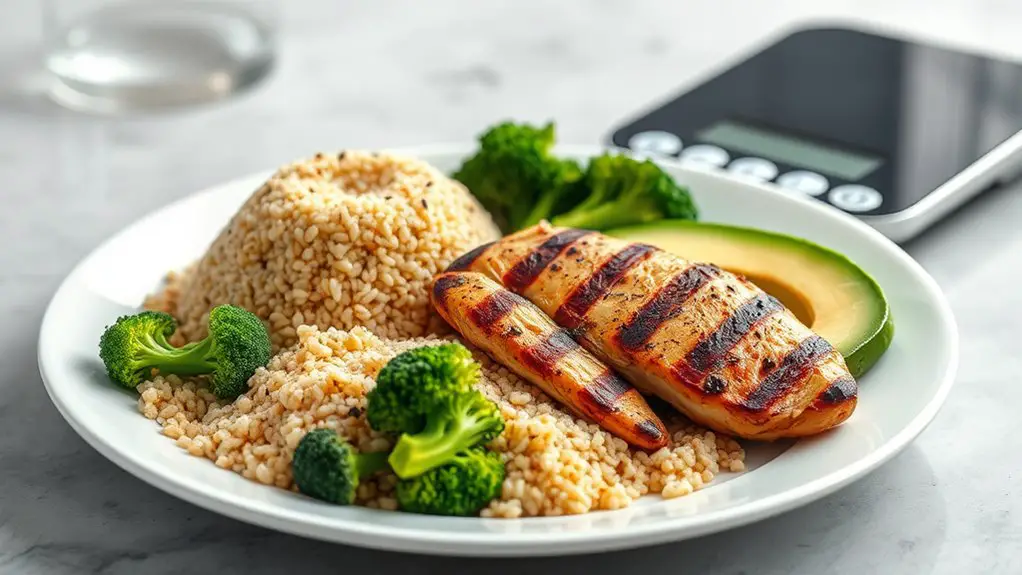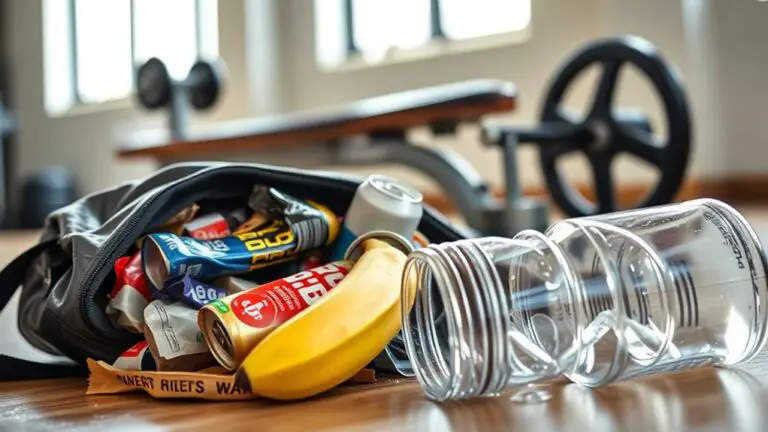How to Gain Muscle Without Gaining Fat

To gain muscle without gaining fat, combine effective strength training with a balanced diet. Focus on compound exercises like squats and deadlifts while ensuring proper form. Optimize your macronutrient intake, aiming for 30% protein, 50% carbs, and 20% fats. Incorporate moderate cardio 3-4 times a week and allow adequate recovery time between workouts. Monitor your progress and adjust your strategy as needed to avoid common pitfalls. There’s so much more to explore to enhance your results!
Understanding Muscle Gain and Fat Accumulation

When you’re aiming to build muscle without adding fat, it’s essential to understand the balance between these two processes. Muscle physiology involves how your body repairs and grows muscle fibers in response to resistance training. To effectively gain muscle, you need to challenge your muscles while allowing adequate recovery time.
On the flip side, fat metabolism plays an important role in preventing unwanted weight gain. By maintaining a caloric balance, where you consume enough energy to support muscle growth without exceeding your daily needs, you can minimize fat accumulation.
Incorporating strength training alongside cardiovascular exercises can optimize both muscle growth and fat loss. Remember, it’s not just about lifting weights; it’s about creating an environment where your body can thrive. By focusing on muscle physiology and managing fat metabolism, you’ll be on your way to achieving your fitness goals safely and effectively.
The Importance of a Balanced Diet
A balanced diet plays a pivotal role in your muscle-building journey while keeping fat accumulation in check. By focusing on whole foods, you’ll guarantee your body receives the essential nutrients it needs to fuel workouts and recover effectively. Meal planning is essential; it helps you prepare nutrient-dense meals ahead of time, reducing the temptation to opt for unhealthy options.
Incorporating nutrient timing into your diet can also enhance your muscle gains. Consuming the right macronutrients around your workouts provides your muscles with the energy they need for performance and recovery. Aim to eat a combination of carbohydrates and protein before and after exercise to maximize your results.
Macronutrient Ratios for Muscle Growth

To effectively gain muscle while minimizing fat, understanding the right macronutrient ratios is important. Aim for a balanced intake of protein, carbohydrates, and fats to support your body’s needs. A good starting point is around 30% protein, 50% carbs, and 20% fats. Protein plays a significant role in muscle repair and protein synthesis, so make sure you’re getting enough to promote growth.
Nutrient timing is also important; try to consume a protein-rich meal or snack within 30 minutes after your workout to maximize recovery. This helps your body utilize amino acids effectively, aiding in muscle development. Carbohydrates are essential for replenishing glycogen stores, so don’t neglect them. Healthy fats support hormone production, which can further enhance muscle growth. By carefully balancing these macronutrients and paying attention to when you eat, you can achieve your muscle gain goals while keeping unwanted fat at bay.
Effective Strength Training Techniques
Balancing your macronutrients sets the stage for effective strength training, which is key to gaining muscle without adding fat. Focus on compound exercises like squats, deadlifts, and bench presses. These movements engage multiple muscle groups, maximizing your workout efficiency and promoting balanced muscle growth.
To guarantee you’re consistently making progress, implement progressive overload by gradually increasing the weight or resistance you use. This approach helps your muscles adapt and grow stronger over time. Remember to prioritize proper form to minimize the risk of injury—consider working with a trainer if you’re unsure.
Aim for a training schedule that allows adequate recovery between sessions. Your muscles need time to repair and grow, so don’t overlook rest days. By combining compound exercises with a progressive overload strategy, you’ll set yourself up for effective strength training that supports your muscle gains while keeping fat accumulation in check. Additionally, incorporating Renegade Rows can further enhance core engagement and upper body strength.
Incorporating Cardiovascular Exercise

When you’re aiming to gain muscle without adding fat, incorporating cardiovascular exercise is essential. You’ll want to explore different types of cardio workouts and determine the right timing and frequency for your routine. Finding the balance between strength training and cardio can help you achieve your fitness goals effectively. One effective option is skipping rope, which not only elevates your heart rate but also provides a full-body workout.
Types of Cardio Workouts
Incorporating cardiovascular exercise into your routine can be a game-changer for gaining muscle without adding excess fat. You can choose between High-Intensity Interval Training (HIIT) and steady-state workouts. HIIT benefits include increased calorie expenditure and muscle preservation, making it ideal for those short on time. On the other hand, steady state advantages lie in its low impact and suitability for longer workout durations, keeping you in fat burning zones. Balancing cardio intensity and frequency is essential; too much can hinder muscle gains. Consider incorporating recovery workouts, focusing on low-intensity exercises to support endurance training. By understanding these types, you can optimize your cardio without compromising your muscle-building goals.
Timing and Frequency
To maximize your muscle gains while minimizing fat accumulation, it’s essential to pay attention to the timing and frequency of your cardiovascular workouts. Ideally, you should schedule cardio sessions around your meal timing to guarantee that your body has the necessary nutrients for recovery. Aim for moderate cardio 3-4 times a week, incorporating shorter sessions post-strength training to boost fat oxidation without hindering muscle growth.
| Day | Cardio Type | Duration |
|---|---|---|
| Monday | Steady-State | 30 mins |
| Wednesday | HIIT | 20 mins |
| Friday | Low-Intensity | 40 mins |
| Saturday | Steady-State | 30 mins |
| Sunday | Rest | N/A |
Balancing workout frequency with proper nutrition keeps you on track for your goals.
The Role of Recovery and Sleep
Although you might focus on your workouts and diet, recovery and sleep play essential roles in gaining muscle without unwanted fat. Implementing effective recovery techniques, like stretching and foam rolling, helps reduce soreness and promote muscle repair. These practices, combined with a well-structured routine, can keep your body in ideal shape.
Sleep hygiene is equally important. Aim for 7-9 hours of quality sleep each night. Create a calming bedtime routine, limit screen time before bed, and maintain a consistent sleep schedule. This not only enhances muscle recovery but also balances hormones that regulate appetite and fat storage.
Monitoring Progress and Adjusting Strategies
Tracking your progress is essential for gaining muscle without adding fat. Regularly monitoring your workouts, nutrition, and body composition helps you see what’s working and what needs tweaking. This way, you can make informed strategy adjustments to optimize your results. Here’s a simple table to help you assess your progress:
| Week | Weight (lbs) | Muscle Gain (lbs) |
|---|---|---|
| 1 | 150 | 0 |
| 2 | 151 | 1 |
| 3 | 152 | 1.5 |
| 4 | 152 | 1.5 |
| 5 | 153 | 2 |
Common Mistakes to Avoid When Gaining Muscle
When you’re trying to gain muscle, it’s easy to make some common mistakes that can hinder your progress. One of the biggest pitfalls is overeating calories, which can lead to unwanted fat gain. Additionally, neglecting cardio workouts can affect your overall fitness and muscle definition, so let’s explore how to avoid these traps.
Overeating Calories
While it might seem tempting to pile on the calories in hopes of building muscle quickly, overeating can lead to unwanted fat gain. To effectively gain muscle, you need a careful caloric surplus, but that doesn’t mean you should go overboard. Focus on quality calories rather than just quantity. Prioritize nutrient timing, making sure you consume protein and carbs around your workouts for ideal recovery and muscle growth. This approach helps maximize the benefits of your caloric surplus while minimizing fat gain. Remember, it’s about finding the right balance; aim for gradual increases in calories instead of drastic jumps. By being mindful of your intake, you’ll foster muscle growth safely without compromising your physique.
Neglecting Cardio Workouts
Many people make the mistake of neglecting cardio workouts while focusing on muscle gain. It’s a common myth that cardio will hinder your muscle-building efforts; however, this isn’t entirely true. Incorporating cardio can actually help maintain a healthy weight and improve your heart health, which is vital for overall performance. You don’t have to run marathons; consider low-impact cardio alternatives like cycling or swimming. These can boost your metabolism without burning excessive calories needed for muscle growth. Remember, balance is key. By integrating cardio into your routine, you can avoid common cardio misconceptions and support your goals effectively. Just make sure you’re not overdoing it, allowing your muscles the recovery they need to grow strong.
Frequently Asked Questions
Can Supplements Help in Gaining Muscle Without Fat Gain?
Oh sure, you’re just a scoop away from becoming a muscle-bound Adonis, right? But let’s get real. Supplements can help, but they’re no magic potion. Timing your protein intake and embracing creatine benefits can give you an edge. Just remember, it’s not all about the powders; a balanced diet and exercise are key. If you play it safe and smart, you might just find your ideal gains without the unwanted fluff!
Is Fasting Beneficial for Muscle Gain and Fat Loss?
Intermittent fasting can be beneficial for muscle gain and fat loss, but it’s essential to approach it safely. By strategically timing your meals, you can promote muscle preservation while still allowing your body to burn fat. Just make certain you’re consuming enough protein and calories during your eating windows. If you’re considering this method, it’s wise to consult a healthcare professional to confirm it aligns with your individual health needs and goals.
How Does Hydration Affect Muscle Growth and Fat Accumulation?
Isn’t it ironic how many folks overlook hydration while chasing their fitness goals? You need to focus on effective hydration strategies; your water intake plays an essential role in muscle growth and fat management. Staying well-hydrated helps optimize performance and recovery, ensuring your muscles can grow efficiently. Plus, proper hydration can help prevent excess fat accumulation. So, grab that water bottle and make hydration a priority—you’ll thank yourself later!
Should I Avoid Carbs Completely for Muscle Gain?
You shouldn’t avoid carbs completely for muscle gain. Carbohydrates are essential for fueling your workouts and recovery. Instead, consider carb cycling, which involves varying your carb intake based on activity levels. This approach can help you maintain balanced nutrition while promoting muscle growth. Remember, a well-rounded diet with appropriate carbs, proteins, and fats will support your goals safely and effectively. Moderation and balance are key to success in your fitness journey.
Can Stress Impact My Muscle Gain and Fat Levels?
You might not realize it, but stress can play a sneaky role in your fitness journey. When you’re under stress, your cortisol levels spike, which can lead to unwanted fat gain and hinder muscle growth. Effective stress management techniques, like meditation or regular exercise, can help keep those cortisol levels in check. By prioritizing your mental well-being, you’re not just protecting your gains, but also creating a healthier environment for your body to thrive.





